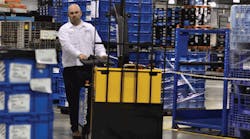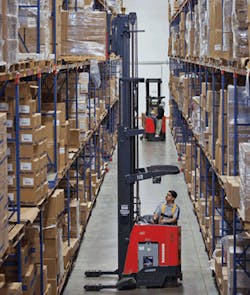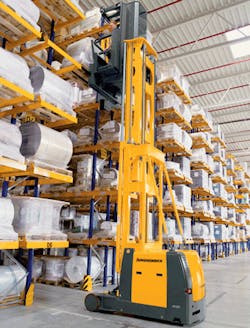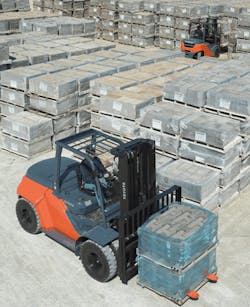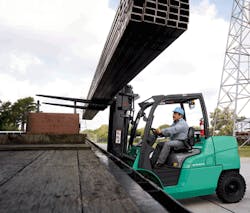At a time when skilled workers and the time they need to get work done are at a premium, the latest generation of powered industrial trucks is getting more attention. Although there are still many vehicles from previous generations being maintained to stay on duty, the jobs they're being called to do require more sophisticated skill sets related to time, space, labor and asset management. The common denominator is information, and managers crave the kind of information industrial trucks can generate.
See Also: Powered & Automated Vehicles
Tom Bonkenburg, director of European operations for the consulting firm St. Onge Co. says U.S. end users who have been slow to accept lift trucks as anything but dumb product movers are now ready for a change, and lift truck OEMs and dealers are ready to help them make it.
"We are basically on the doorstep of this new technology," he says. "Computer speed doubles every two years for the same price and one of the main drivers of robotic technology advancement is computer crunching power. As the mainline forklift companies embrace the technology that will turn their forklifts into AGVs, we will start to see a lot of example sites come online. For example, Seegrid has partnered with Linde in Europe and Raymond in the U.S. to help add 'smarts' to their product lines. You will begin to see these companies rolling out this type of ‘robot fork truck' technology in many of their models over the next few years."
Automating Lift Trucks
That vision is happening now at New South Express, which has deployed four Seegrid GP8 robotic industrial trucks, two single pallet trucks and two double-length pallet trucks.
New South Express, based in Lincoln, Ala., is a consolidation center for Honda Manufacturing of Alabama, and employs more than 900 associates. This site sequences direct-to-line-side delivery, handling 200,000 touch points per day.
Recently the company was experiencing production increases that would require them to either add manpower and man-operated equipment or automate. It chose the latter option.
New South unloads trucks using a man-operated forklift, but relies on the Seegrid vehicles to transfer empty pallets over long runs and finished goods on shorter runs. These moves are considered non-value-added travel, and considering its site covers a half million square feet, that's a lot of potentially lost value.
Associates pick goods to a pallet, which is then secured and loaded onto a truck in production sequence for delivery to the Honda plant. New South relies on their returnable container center (RCC) to handle the empties—pallets and containers that need to go back through the supply chain. To deliver them to the RCC, New South used to rely on its core lift truck operators who were loading trailers. They would have to retrieve these pallets and deliver them—which would take up to 8 minutes off their core processes.
"We were at an 8-hour shift and now at 10 hours," says Dave Vanbrimmer, engineering department manager for New South Express. "They'd continuously have to leave their core job and still have to get that job done in addition to this one. The automated vehicles allow us to keep those operators working. We teach the vehicles and they move the pallets and containers."
Conveyors were considered, but it was determined that they would reduce space utilization, and with only 20 feet of vertical space to play with, automated storage and retrieval was also ruled out.
The focus with the robotic vehicles is not only to save labor, but to enhance SQCDM: safety, quality, costs, delivery and morale. With this being the site's first exposure to automated vehicles, there was concern among associates about safety.
"Through demonstrations we were able to show that we had a safe piece of equipment entering their environment," Vanbrimmer says. "If an object or person interrupts the path of the robot, it will come to a complete stop and wait until the obstruction has been cleared before it continues on its route."
Operators Still Needed
Some warehouse operations still require the flexibility of a human operator, which is why several OEMs offer an AGV option for certain applications. For example, Jungheinrich's Warehouse Navigation System uses transponder radio frequency identification (RFID) technology to control a guided very-narrow-aisle (VNA) lift truck within the aisles of a warehouse. Michael Wiesenegg, product line manager for Jungheinrich, says one disadvantage of fully automated systems is the trucks drive slower. But a disadvantage with a non-automated scenario is training time in a VNA setup.
"If you have a lot of turnover in your building or seasonal workers, you have to train them on your racking layout to find the pallet positions they need to pick from or replenish," he says. "We say let the WMS manage that and tell the truck and the operator where they need to go so the driver can focus on driving and then the truck can select the most efficient and quickest route to that pallet position. By doing that, we increase productivity and reduce the risk of product damage."
For this to work, however, the system owner needs a well-designed WMS. The better the WMS system and inventory are managed, the better the information going into the system, and the more accurate is the information feeding into the lift truck.
"A lot of customers using pick tickets today don't have a fully operational WMS system, so if the pallet position on the pick ticket is not correct," Wiesenegg says, "that truck will go to the wrong position. But if you have a WMS that's 100% functional, the WMS automatically sends the position to the truck so the operator doesn't have to type that position in, which saves even more time."
Alternative Power Trends
As industries decide how best to deal with economic and environmental pressures, alternative power sources like fuel cells and lithium ion batteries continue to gain and lose juice on the trend-o-meter. However, while fuel cells have gotten spikes of attention industry-wide for powering Class 1, 2 and 3 forklifts in the last few years, some industries requiring high-capacity trucks stay devoted to the power that internal combustion engines provide.
During the recession many of these fleets were downsized, particularly in construction-related industries. Now that the recession is over and business is picking up, these fleets need to be replenished. That means fleet owners purchasing new equipment will be paying for cleaner equipment. All heavy lift truck manufacturers who sell new equipment in North America must start offering engines that comply with EPA's Tier-4 final diesel regulations.
For example, Toyota's new 8-Series large diesel lift truck line (8,000 to 17,500 lb.) has a 3.0-liter, 4-cylinder, high performance engine that more precisely controls the amount of fuel being injected and burned, resulting in greater fuel efficiency. These kinds of EPA-compliant vehicles will gradually be showing up at home improvement centers, lumber yards, businesses handling concrete, masonry and brick, and anywhere internal combustion engines are required.
Another option on the electric side, however is 80-volt electric pneumatic lift trucks.
"These trucks closely match the performance characteristics of internal combustion trucks, are able to work in outdoor environments and have no emissions," says Cesar Jimenez, national product planning manager for Toyota Material Handling U.S.A. "The EPA and CARB regulation changes have caused many customers to look at and evaluate alternative power sources like this to meet the needs of their applications."
These regulations will not only affect what fleet owners decide to purchase, but how, as well. Mark Faiman, product manager for Toyota's IC, ground support and aerial work platform products, believes construction companies probably won't ever go back to owning large fleets.
"They'll leave it up to the rental companies to provide the needed equipment and to factor those costs in to the bid process," he says. "That way they reduce their paperwork and personnel costs requiring them to meet rules affecting fleet emissions, and are quickly able to adjust their costs to meet the swings present in the construction industry."
What about Fuel Cells?
For years various federal, state and local government entities have experimented with offering incentives to increase the demand for hydrogen. But Jimenez believes the case for fuel cells is losing its potency.
"Only a few large customers were able to take advantage of those incentives as their fleets were large enough to bring down the overall cost of moving to this fuel source from conventional battery power," he says. "Recently we have seen the demand for this type of technology in the lift truck industry begin to decline as the cost of the hydrogen fuel has not dropped to an affordable state and the cost of the infrastructure that houses the hydrogen fuel continues to be extremely high."
Nevertheless, some users have recently been able to make a strong holistic case for hydrogen power going beyond lift trucks.
Infrastructure development provides a bigger stage on which to present fuel-cell-based technologies. A great example can be found at ports, says Ed Kiczek, global business director for hydrogen energy systems at Air Products, providers of industrial gases. It is at these ports where big Class 7 and 8 trucks powered by fuel cells are being used for drayage. There's also an effort to use fuel cells to power refrigeration units on trucks. Kiczek believes that such a big-picture context will grow fuel cell applications in lift truck fleets.
"We have several customers using fuel cells as emergency backup power, some even as base load or peak shaving power, where we're providing the hydrogen into a fuel cell for those applications," he says. "We're also working with a couple ports to take that holistic view of goods movement and most of them have serious non-attainment issues. That's their biggest driver, to clean up the environment and use hydrogen as a zero emissions fuel."
Kiczek hasn't given up on the automotive sector adopting fuel cell power, either. In fact he believes that's the industry that will make this technology more cost justifiable for a broader range of applications.
"Automotive applications will be orders of magnitude bigger than material handling," he says. "Hyundai went into production for a limited number of vehicles in April 2013 and some others are announcing they'll go into production in 2014-2015, so we're on the cusp of going to mass production of fuel cells and driving the cost down even more."
Automotive manufacturers are also using fuel cells in support of their plants, not only in the lift trucks that serve their production lines, but in the machines that scrub the floors on which those lift trucks operate. John Lee, vertical marketing manager at Nilfisk Advance, has found a market niche for his company's fuel-cell-powered floor scrubbers at these plants as well as those of food and beverage companies.
"We ran into customers where their entire material handling fleet is running on hydrogen fuel cells but their scrubbers were left out of the mix," he says. "Now we're selling into 600,000 and 700,000 sq-ft. facilities running three shifts 24/7. These are operations that need to clean every shift, and running on fuel cells is a real advantage for them because they're never down. It takes two minutes to refuel the scrubbers and they're back up and running."
This is the kind of sustainability that brings an ROI, and therefore makes a stronger case for fuel cells.
Whether your application is best served by fuel cell-, battery-, or internal-combustion-engine-powered lift trucks, the biggest cost associated with these vehicles is still the operator. As information technology develops your next purchasing decision might be "driver or driverless?"
